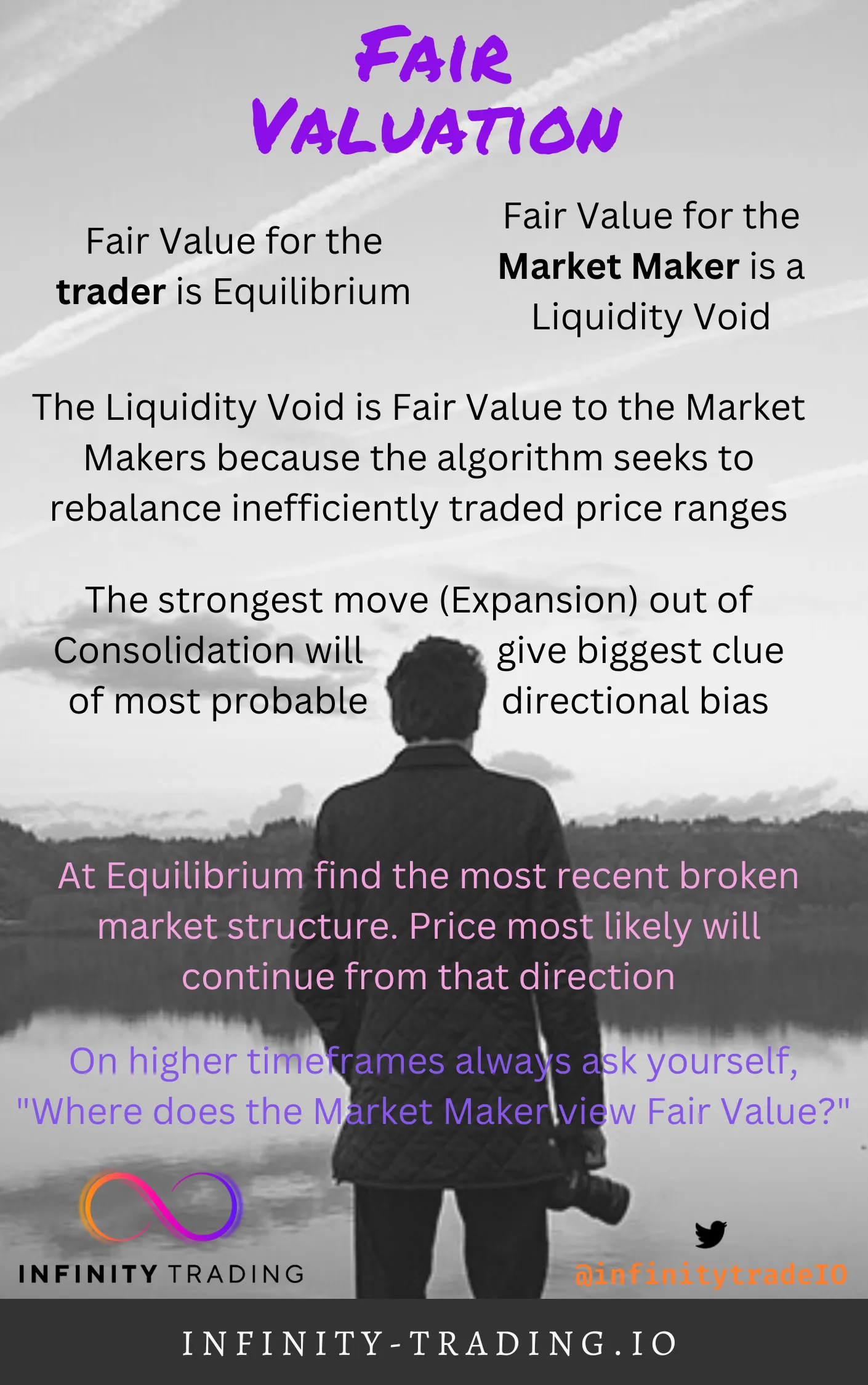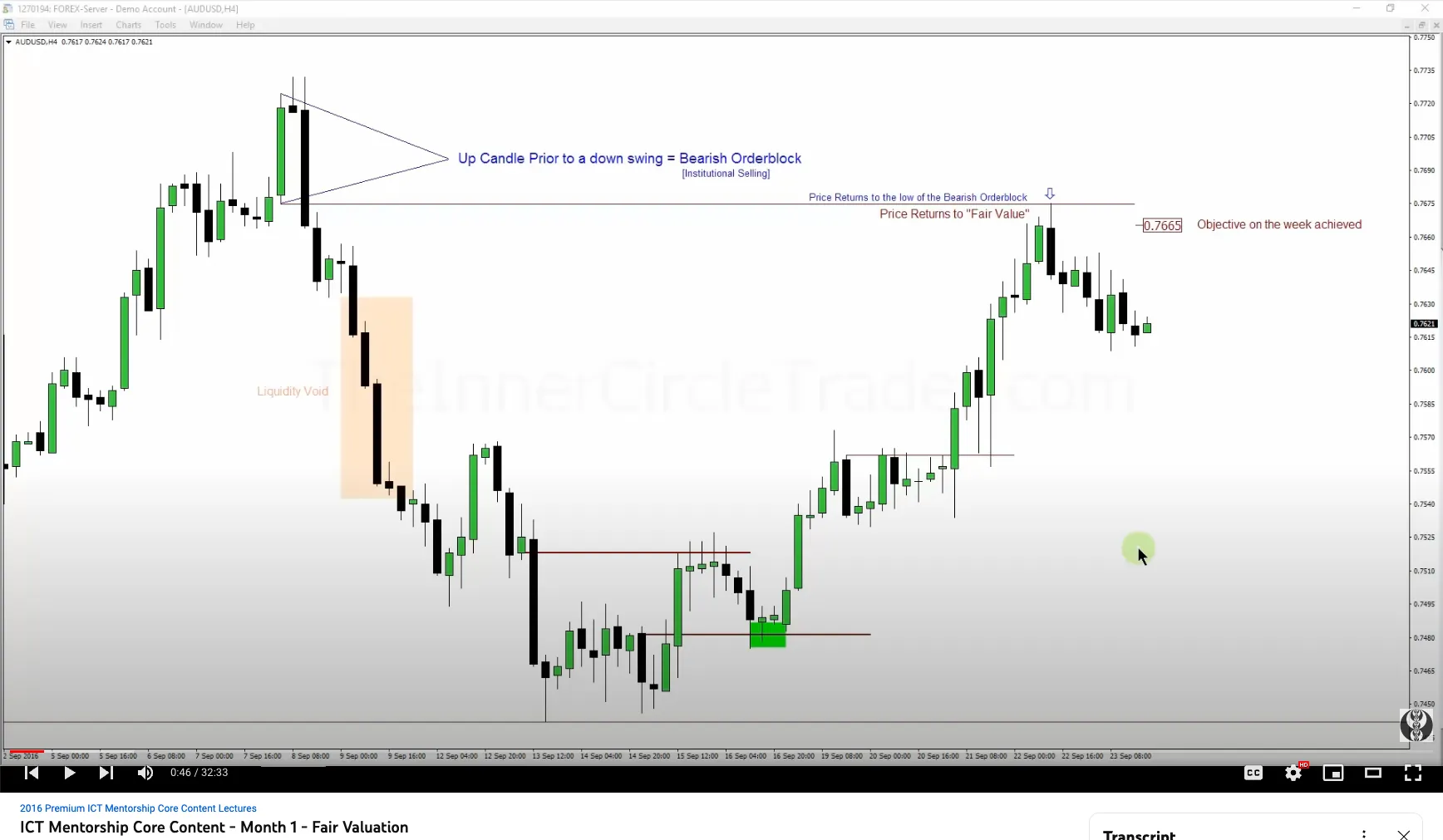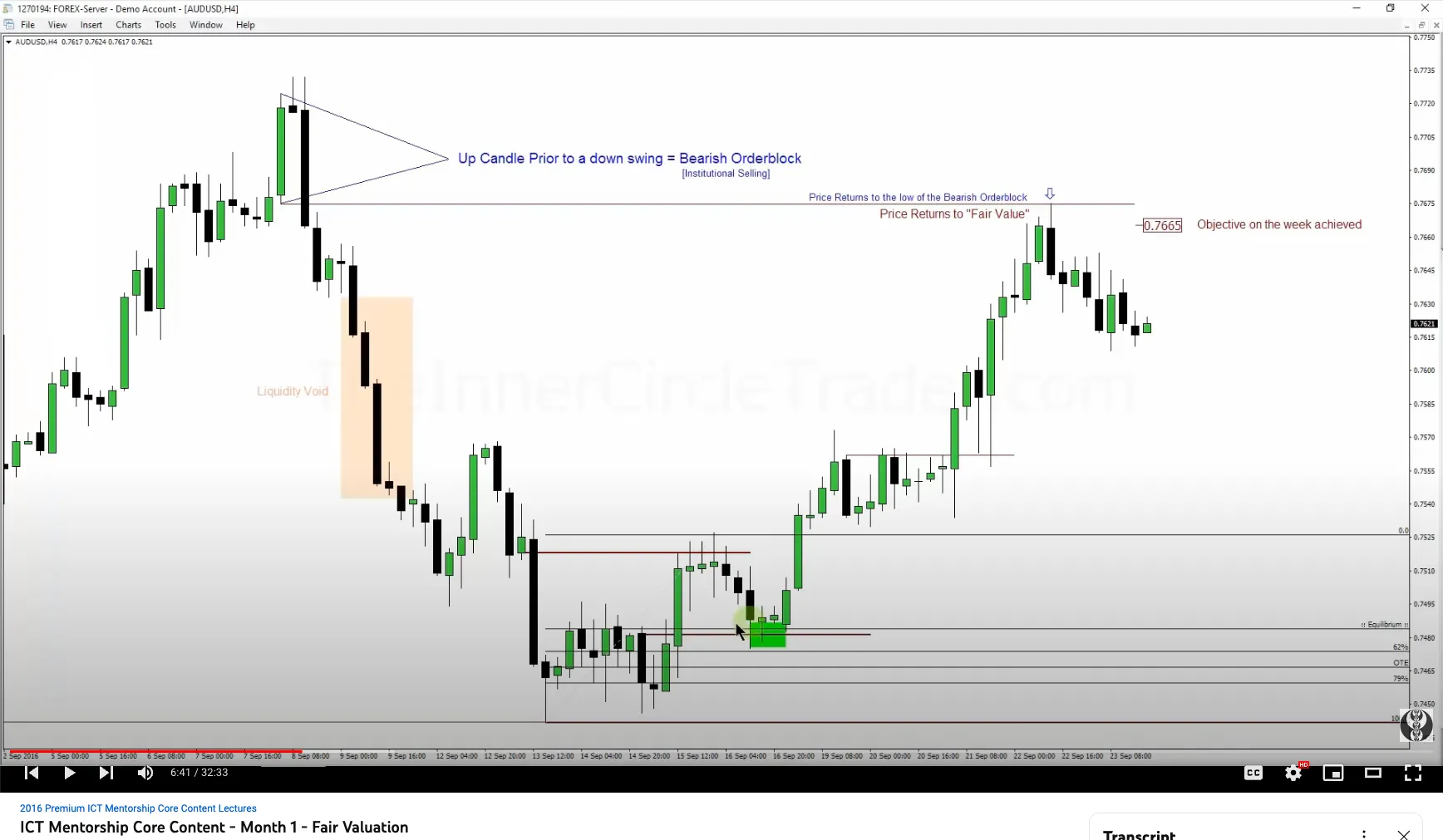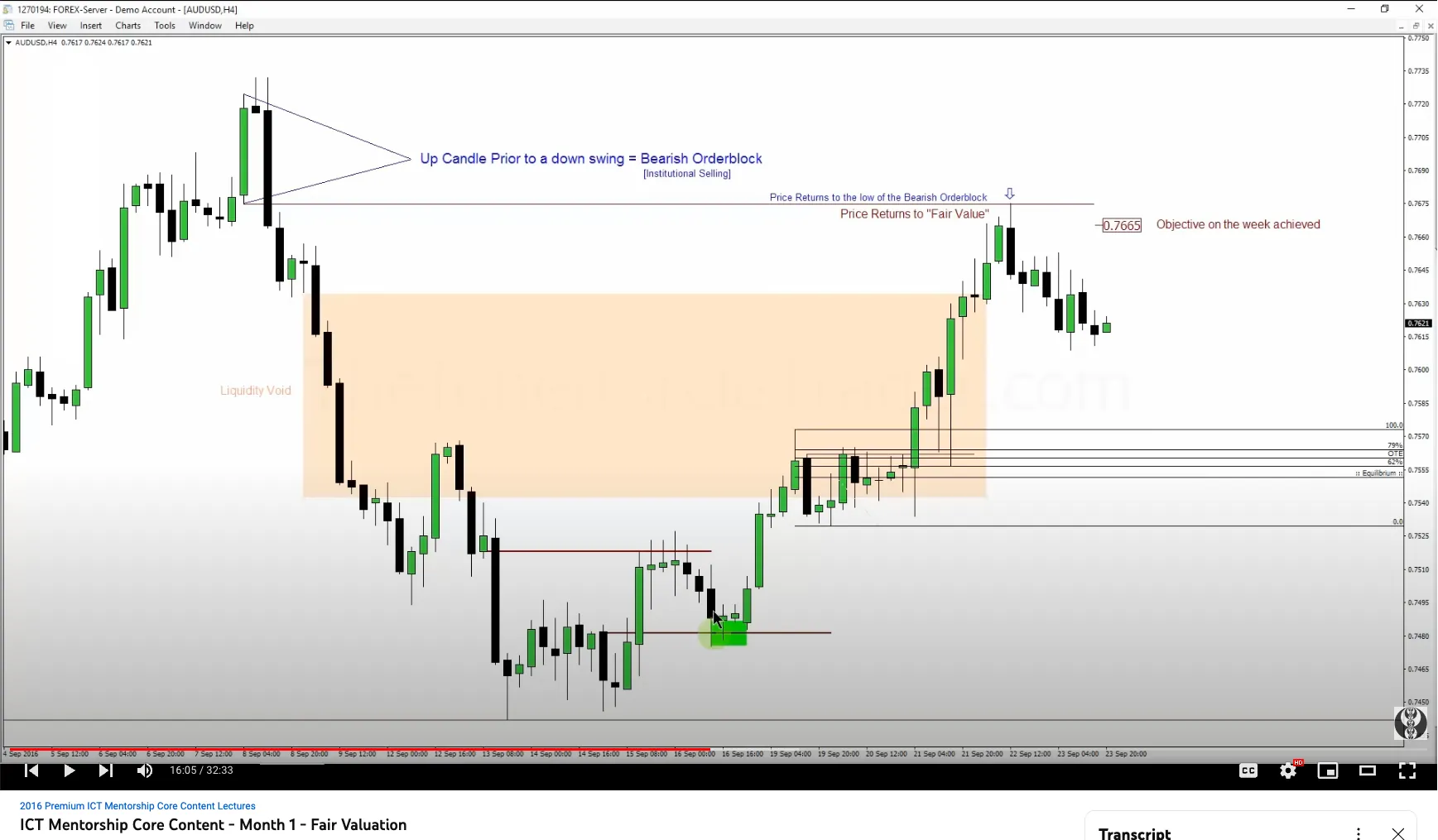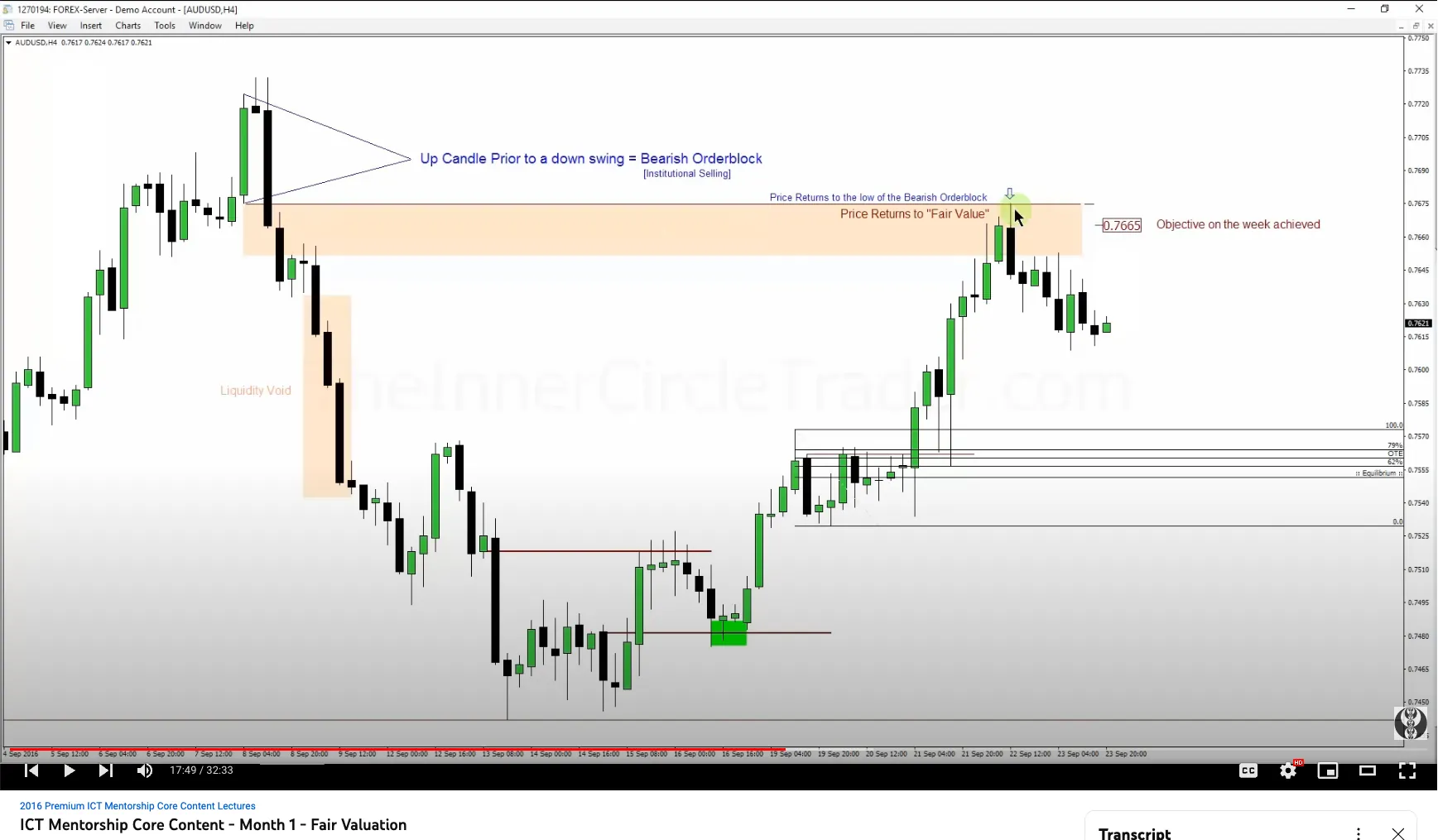Fair Valuation
Video 6/8
- Fair Valuation from two perspectives:
- Fair Value as the equal distance between a swing high and swing low (Equilibrium)
- Fair Value from the point of view of the Market Makers
- If you are a Buyer you want to be in a Discount Market (below Equilibrium) and buying in the lower third of the current trading range which is the most recent impulse price movement
- If you are a Seller you want to be in a Premium Market (above Equilibrium) and selling in the upper third of the current trading range
Liquidity Voids
- Liquidity Void = price makes a sudden movement in one direction over a large range (compared to recent candle size) in a short amount of time. The candles are characterized by large beefy bodies with tiny wicks
- A Liquidity Void means price spent very little time trading at those prices
- Liquidity Void characteristics:
- When price is on the other side of the Liquidity Void (after just creating it) then the Liquidity Void is considered Fair Value and the Market will want to come back to it because there was very little trading in it
- But price doesn’t have to trade back to the Liquidity Void immediately
- The Liquidity Void is Fair Value to the Market Makers because the algorithm seeks to rebalance inefficiently traded price ranges (which is the definition of a Liquidity Void)
- When price is on the other side of the Liquidity Void (after just creating it) then the Liquidity Void is considered Fair Value and the Market will want to come back to it because there was very little trading in it
- Liquidity Void Trading:
- When price trades back into a Liquidity Void expect price to wick up and down as price fills the Liquidity Void
- This is because Market Makers are selling their long positions or buying back their short positions in the range of the Liquidity Void that was accumulated beforehand
- Once the Liquidity Void is filled in look for farther up/down (farther in a premium or discount) Fair Value Gaps or ICT Orderblocks where Market Makers will look to offset their positions they got on the other end of the premium vs discount move
- When price trades back into a Liquidity Void expect price to wick up and down as price fills the Liquidity Void
Liquidity Voids vs Fair Value Gaps
- It is the speed and the range that differentiates a Liquidity Void from a Fair Value Gap
- Liquidity Voids cover more range faster than a Fair Value Gap
- Fair Value Gap = three candle pattern where there is no overlapping between the first and third candles
- When inefficiencies in price occur (which are Fair Value Gaps & Liquidity Voids) Market Makers uses the inefficiencies to exit or enter trades
Equilibrium
- Equilibrium is the 50% (or middle point) line between a swing high and a swing low
- Mark out the Equilibrium on the current trading range. Then draw the Equilibrium on the next largest trading range. And the next. Etc.
- Is the current price in a Discount or Premium in all or many of them? Is price in the lowest or highest third?
- When price is at Equilibrium you need to refer to where the most recent price swing took place
- Because at Equilibrium (or Fair Value) price can go either direction
- The easiest way to determine the most probable next direction is finding where market structure broke most recently
- Did price break a swing high most recently or did price break a swing low most recently?
- Also notice what part of the big overall range price is in. Is price is the lower part, upper part, or near the middle?
- Pay attention to the bodies of the candle when price is around Equilibrium
- Does the bodies of the candles stay on one side of Equilibrium while the wicks cross it? This gives hints that price may reverse after the wicks go across the Equilibrium
“Fair Value”
- “Fair Valuation” is only for the Market Maker and not for the trader.
- When analyzing current price action ask yourself:
- Is price a Fair Value for Market Makers to go buy in?
- Is price a Fair Value for Market Makers to sell in?
- When price returns back to an area of Fair Value that is a fair value for the Market Maker to either sell or buy at
- Market Makers have to deal in terms of Fair Valuation for their short and long positions. They also have to do the same Fair Valuation for their exists on both sides of the marketplace
- On higher timeframes always ask yourself where does the Market Maker view Fair Value?
- To ascertain Fair Value look for three things:
- Find the total macro range of larger price move (Premium or Discount)
- Where is the Equilibrium price point (of the larger price move) relative to the most recent trading range high and low?
- Where are the reference points that Market Makers will aim for? (FVGs, Liquidity Voids, Orderblocks)
Consolidation
- When price moves in defined trading range (i.e. Consolidation) there is going to be Equilibrium
- Equilibrium in itself is Fair Value.
- When consolidation is broken, the strongest move on an higher timeframe out of that consolidation will give you a great deal of prognostication for directional bias
- Look for price to continue trading in the direction of the strong move out of a consolidation
- If we see expansion then we know that prior to the expansion was consolidation
- But we don’t know how long price will stay in a consolidation
Turtle Soup
- If price is a Turtle Soup setup price should reject quickly after taking out an old high/low. But if price consolidates after taking out an old high/low (liquidity) it is likely to continue going the direction it was going
- If price consolidates then it is creating an Equilibrium
- If price consolidates in a range then mark the Equilibrium of the consolidation range
Determining Next Price Action
- When trying to determine what price is most likely to do next?
- Where is price in the macro price swing? Discount or Premium?
- Are there other smaller swings inside the macro price swing? Apply the OTE levels to that price swing. Discount or Premium?
- Where are the Liquidity Voids? These are what Market Makers consider as Fair Value
- Where is the most recent break in market structure? (took out a swing high or took out a swing low?)
Market Makers
- The Market moves:
- From buy stops to sell stops and sell stops to buy stops
- From Fair Value to Discount, Discount to Premium, Premium to Fair Value
- Are we in a Premium? Are we at a Discount? Are we at Fair Value?
- Are Market Makers accumulating, manipulating, or are they distributing?
- The only reason why price is allowed to be delivered at higher prices is because the Market Makers are net long and it’s in their interest for price to go higher. It doesn’t matter how many Retail traders buy or sell. The price is going to be set by the Market Makers and they are going to do things to line their own pockets and not Retail traders.
- It takes a perspective shift (remember the market efficiency paradigm that ICT taught) to view things from the Smart Money’s perspective and not what Retail logic teaches
- Price action is not random. Market Makers specifically move price to where they want it to go and and Market Makers control the reason why price goes in a direction
- This is why if you mess up a trade or miss a move, don’t worry about it. The market will give you another chance almost every day. Because everything repeats! Because everything is controlled by Smart Money (i.e. Market Makers)


